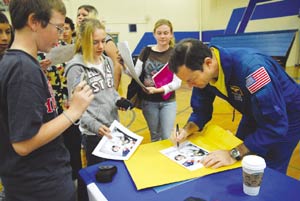A ripple of repressed excitement ran through the crowd of
Britton Middle School eighth-graders as the lights came up in the
gym Wednesday morning following Capt. Michael Lopez-Alegria’s
presentation on his several space flights for NASA.
MORGAN HILL
A ripple of repressed excitement ran through the crowd of Britton Middle School eighth-graders as the lights came up in the gym Wednesday morning following Capt. Michael Lopez-Alegria’s presentation on his several space flights for NASA.
Now they could ask the California native and Harvard graduate all about what it was like to be in space. Hands shot up every time Lopez-Alegria asked for questions from the clearly excited bunch.
Lopez-Alegria, 49, has more than 257 days of space time during four different missions. In October 1995, he spent 16 days on the Columbia serving as flight engineer. He spent 13 days on the Discovery in October 2000 as part of a seven-member crew working on the International Space Station and completed two space walks. Two years later, Lopez-Alegria spent two weeks in space between Nov. 23 and Dec. 7, 2002, on the Endeavour as a part of the 16th shuttle mission to visit the space station. His most recent mission lasted 215 days on the space station, leaving from and returning to Earth aboard a Soyuz spacecraft. He completed five spacewalks for 33 hours and 42 minutes.
During his hour-long visit to the middle school, the former flight instructor touched on his different missions, but spent the most time making his time in the space station come to life for the students and teachers gathered in the gym. Everyone watched, entranced, as he showed footage from his more than half-a-year in space.
Lopez-Alegria decided to talk with Britton students as he was on a business trip to Morgan Hill-based EDO Corporation Reconnaissance and Surveillance Systems. He said he and fellow astronauts typically try to visit schools whenever possible.
Though there was the occasional silly comment, the children asked mostly thoughtful and interesting questions. One student asked how astronauts prepare mentally and emotionally to be away from their families so long. Lopez-Alegria mentioned that he was actually more fortunate than some who are deployed away from their families because he phoned his 7-year-old son every day while he was on the space station.
Another student asked about bacteria surviving on meteors that come through the atmosphere and fall to earth. One asked if the Soyuz capsule and the space shuttle were hot inside when they passed through the atmosphere. The former naval test pilot told the students that astronauts remain comfortably cool during the transition, even as they can see flames shooting by the windows.
Robert Sullivan, 13, said he wasn’t sure what he’d learn when he heard an astronaut was coming to talk to he and his fellow classmates.
“It was very interesting to see what life was like while he was on the space station,” he said. “It wasn’t like what I expected it would be.”
Steven Gamboa and Robbie Rubenzer, both 13, said they thought the whole presentation was “pretty cool.” One of the things they thought was interesting was the way astronauts eat.
Chawntell Lowe, 13, was excited to meet an astronaut who had spent so much time in space.
“I learned a lot of stuff I didn’t know,” she said. “I always thought when you were in space, you could see the stars, and I learned they look at the Earth.”
An eighth-grader who says she might want to be a veterinarian or work with computers, Chawntell listened to Lopez-Alegria’s message about preparing for a career.
“It seems like whatever you want to do, you have to work hard,” she said.
Knowing that message had hit home for Chawntell is important to him, Lopez-Alegria said after the presentation. He said his reason for visiting schools and his message to students isn’t very original, but he believes it’s important.
“I want to try to help them understand how important it is to stay in school, to study and work for what they want,” he said. “This is a pivotal point in their lives … You know how, with a golf club, a tiny little change in the angle of the club head as it touches the ball makes a big difference in what happens down the course.”








